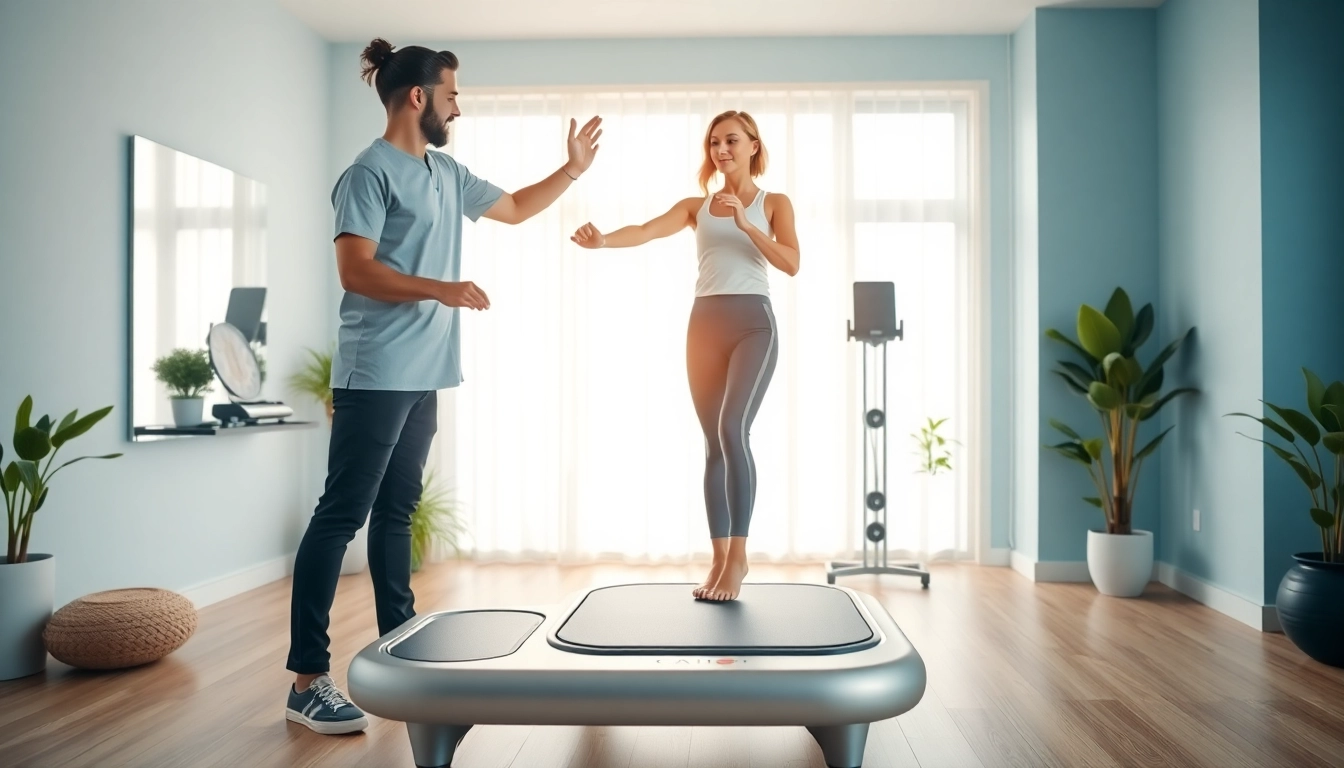Introduction to Whole Body Vibration Therapy
Whole body vibration therapy, often abbreviated as WBV therapy, has become a popular approach in the wellness and fitness industry. This innovative treatment method uses mechanical vibrations to stimulate the body, enhancing overall health and wellness. While many individuals are becoming aware of its benefits, there remains a significant amount of misinformation and misunderstanding regarding its applications and effectiveness. This comprehensive guide aims to clarify what whole body vibration therapy is, its historical context, the underlying mechanics of how it works, and its various benefits.
By the end of this article, you will understand how whole body vibration therapy can play a pivotal role in enhancing your physical and mental well-being.
What is Whole Body Vibration Therapy?
Whole body vibration therapy entails a therapeutic treatment where an individual stands, sits, or lies on a machine equipped with a vibrating platform. As the machine operates, it transmits energy to the user’s body, compelling the muscles to contract and relax multiple times per second. This involuntary muscle response can lead to improved muscle strength, flexibility, and overall body awareness.
The therapy is often implemented in various settings, including fitness studios, physical rehabilitation centers, and wellness clinics. It can serve as a complement to traditional exercise or be utilized independently for individuals who may have difficulty with conventional workouts.
History and Development of Vibration Therapy
The origins of whole body vibration therapy can be traced back to ancient civilizations where various forms of vibration and oscillation were used for health benefits. Historical documents suggest that Greek and Roman people utilized vibrating devices in their baths to promote relaxation and muscle recovery. However, modern applications of vibration therapy began to surface in the mid-20th century, largely influenced by research conducted for athletic training and rehabilitation.
Over the years, numerous studies have explored the physiological effects of vibration on the human body, contributing to the development of specialized machines designed specifically for therapeutic purposes. The growth in popularity of vibration therapy is also fueled by advances in technology, which have made the machines more accessible and user-friendly.
How Whole Body Vibration Therapy Works
A typical whole body vibration session involves the individual positioning themselves on a vibrating platform, where the mechanical vibrations are generated. The frequencies can vary, typically ranging from 1 to 50 Hz, depending on the device in use and the specific therapeutic goals. Once the session begins, the vibrations travel through the body, engaging numerous muscle groups.
The process activates the stretch reflex mechanism, prompting muscles to contract in response to the vibrations. These rapid contractions help to enhance muscle strength, improve balance, and boost coordination. Additionally, the vibrations stimulate the lymphatic system and promote blood circulation, aiding in the detoxification process.
Physiological Benefits of Whole Body Vibration Therapy
Improvement in Muscle Strength and Endurance
One of the most significant benefits associated with whole body vibration therapy is its capacity to improve muscle strength and endurance. Research indicates that the mechanical vibrations can activate a higher number of muscle fibers compared to traditional exercise, leading to more significant strength gains in a shorter amount of time.
For instance, individuals engaged in a regular WBV routine often report enhanced performance in both sporting activities and daily tasks. Studies have shown that a mere 15-30 minutes of vibration therapy can equate to hours of conventional strength training, making it an efficient solution for those pressed for time.
Effects on Body Composition and Weight Management
In addition to muscle enhancement, whole body vibration therapy has been positively linked to improvements in body composition. Evidence suggests that regular use of vibration platforms can contribute to fat reduction when combined with a balanced diet and exercise routine. The vibrations stimulate metabolic activity, resulting in increased calorie expenditure even at rest.
The implications for weight management are promising, with some studies indicating that individuals utilizing WBV therapy can experience a reduction in body fat percentage and an increase in lean muscle mass. Thus, WBV can be a valuable tool for those seeking to achieve their fitness goals.
Enhancements in Circulatory and Cardiovascular Health
Whole body vibration therapy has demonstrated considerable benefits for cardiovascular health. The rhythmic contractions stimulated by the vibrations increase blood flow, enhancing circulation throughout the body. This improved blood flow can lead to numerous health benefits, including better oxygen transport and nutrient delivery to tissues.
Moreover, enhanced circulation can have a positive impact on blood pressure levels, reducing the risk of cardiovascular diseases. Regular sessions of WBV therapy may also encourage improved endothelial function, which is crucial for maintaining a healthy cardiovascular system.
Whole Body Vibration Therapy for Pain Management
Alleviating Chronic Pain Conditions
Many individuals suffering from chronic pain conditions have turned to whole body vibration therapy as an alternative treatment method. Studies indicate that WBV therapy may help to alleviate pain associated with conditions such as arthritis, fibromyalgia, and lower back pain.
The mechanical vibrations stimulate the muscles and promote better circulation, which can help to reduce inflammation and pain sensitivity. For those who have tried traditional pain management techniques without success, WBV can provide much-needed relief.
Benefits for Patients with Joint and Muscle Disorders
Whole body vibration therapy offers potential benefits to individuals dealing with joint and muscle disorders. The low-impact nature of WBV makes it an ideal choice for those with limited mobility or chronic conditions that prevent high-intensity workouts. In fact, many rehabilitation programs are now incorporating vibration therapy to help patients recover from injuries or surgeries.
This therapy can assist not just in pain relief but also in increasing strength and flexibility in affected areas. Patients may find that their range of motion improves and their overall functional capabilities increase after regular sessions of whole body vibration therapy.
Role in Rehabilitation and Recovery Processes
The integration of whole body vibration therapy into rehabilitation programs has shown promising results. It can aid in recovery post-surgery by promoting healing and regaining strength in affected areas. Additionally, WBV can help maintain muscle tone and prevent atrophy during periods of inactivity.
Physical therapists often recommend vibration therapy as part of a comprehensive rehabilitation plan, helping patients achieve their recovery goals more efficiently. The ability to target specific muscle groups while minimizing stress on the joints creates a safe environment for healing and healing acceleration.
Psychological and Cognitive Benefits
Impact on Mental Health and Wellbeing
The physical benefits of whole body vibration therapy extend to mental health and emotional wellbeing. Engaging in WBV sessions has been shown to improve mood and reduce feelings of stress and anxiety. The experience of vibration can stimulate the release of endorphins, the body’s natural painkillers, leading to a greater sense of wellbeing.
Moreover, those who engage in regular vibration therapy often report higher levels of energy and motivation, which can create a positive feedback loop encouraging further physical activity and lifestyle changes.
Effects on Cognitive Functions and Concentration
Recent studies suggest that whole body vibration therapy may also have a beneficial impact on cognitive functions. The increased blood circulation resulting from WBV can enhance mental clarity, focus, and cognitive performance. Moreover, the stimulation of certain neurological pathways can potentially improve brain function in older adults and those with cognitive impairments.
This emerging research indicates that employing whole body vibration therapy alongside traditional cognitive training could offer complementary benefits, making it an intriguing area for further exploration.
Reducing Stress and Anxiety Levels
In addition to its physical benefits, whole body vibration therapy has shown potential in stress management. The rhythmic vibrations can facilitate relaxation, similar to techniques used in massage therapy. By calming the nervous system, WBV may reduce cortisol levels, the hormone commonly associated with stress.
Participants often feel an increase in relaxation and a decrease in anxiety levels following sessions, making WBV therapy a beneficial addition for those experiencing high levels of stress or anxiety disorders.
Implementing Whole Body Vibration Therapy in Daily Life
Creating a Safe and Effective Routine
Incorporating whole body vibration therapy into your daily routine can be straightforward and enjoyable. It is essential, however, to establish a safe regimen. Start with shorter durations, such as 10-15 minutes, and gradually increase to 30 minutes as your body adapts to the vibrations.
Consistency is key; aim for sessions several times a week to experience cumulative benefits effectively. However, it is crucial to listen to your body and adjust the intensity and frequency according to your personal comfort levels.
Choosing the Right Equipment
When selecting vibration therapy equipment, various factors should be taken into account, including platform size, frequency settings, and power capabilities. Look for user-friendly machines that come with adjustable settings to cater to both beginner and advanced users. Safety features, such as non-slip surfaces and stable construction, are also important considerations.
Your decision might also depend on your specific health goals; therefore, conducting thorough research or seeking advice from professionals can help you make informed choices.
Consulting Professionals for Optimal Results
While whole body vibration therapy can be pursued independently, consulting with health and fitness professionals can optimize results and safety. A physical therapist, for instance, can tailor a WBV program based on individual needs, monitor progress, and help prevent injuries.
Additionally, professionals can provide insights into integrating WBV therapy with other fitness modalities for a comprehensive health strategy.















Leave a Reply